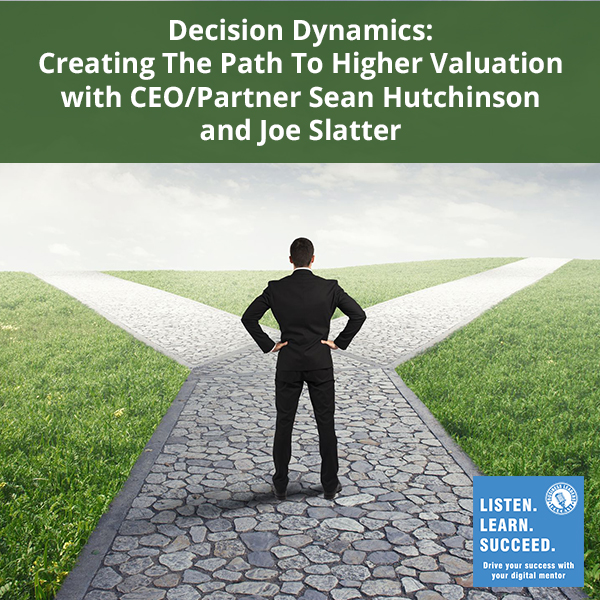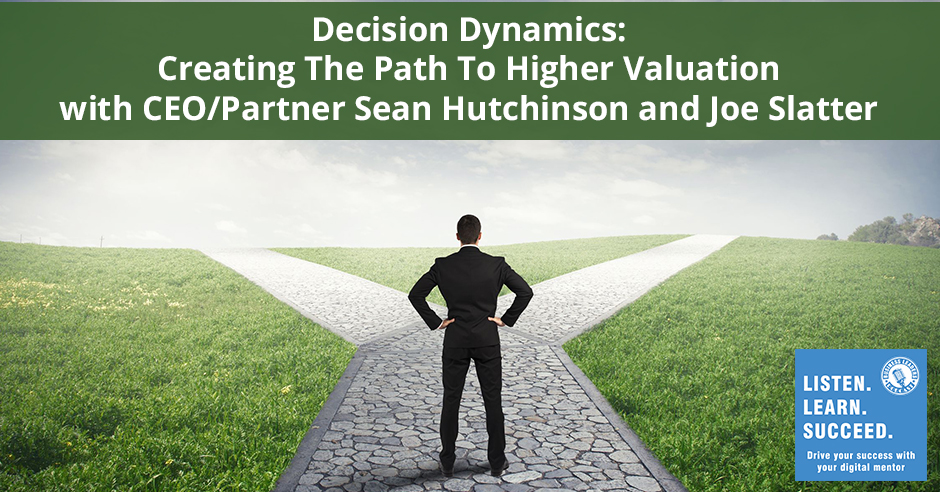Decision Dynamics: Creating The Path To Higher Valuation with CEO/Partner Sean Hutchinson and Joe Slatter


Businesses need constant communication between owners and their team to grow. While it is the common perception that decisions are made from the top, there should be an autonomy that happens among the employees that will make them feel part of the conversation. After all, a business is not only about the leaders; it is also about the team. Sean Hutchinson, CEO at SVA Value Accelerators, is joined by Joe Slatter of SVA Leadership Accelerator to talk about decision dynamics. They put together the relationship and how decisions work, laying down the “what,” “so what,” and the “what now.” Ultimately, decision dynamics work to create higher valuation because it fosters a business where people are held accountable, sharing the responsibilities between the leaders and the team.
—
Decision Dynamics: Creating The Path To Higher Valuation with CEO/Partner Sean Hutchinson and Joe Slatter
Creating The Path To Higher Valuation with CEO/Partner Sean Hutchinson and Joe Slatter
We’re here to talk about decision dynamics and you are probably all wondering, “What is decision dynamics?” There are fancy words that consultants throw around. What this comes down to is operational excellence. That’s something that Sean and I had been talking about ever since we’ve known each other is operational excellence. It comes down to, “Can you make a good decision in a reasonable amount of time?” Everything we do with this content is helping organizations. This isn’t about the boss being able to make better decisions. This is about the whole team being able to make better decisions and driving those decisions as close to the action as we possibly can.
I have Sean Hutchinson, CEO/Partner at SVA Value Accelerators and Joe Slatter, Lead Advisor Decision Dynamics at SVA Leadership Accelerator. We’re doing a continuation of an original podcast where we talked to Sean about SVA. We’re doing a deep dive and we’re going to go into Decision Dynamics.
We talked about making good decisions quickly. How do you do that? Everybody comes into every situation with a way that they’re thinking and a way that they solve problems. The challenge is, they are all different ways. If we’re coming at this from an owner’s perspective, they’re thinking strategically. They’re trying to make the best decisions for the long game. A lot of the folks who may be out in the field are working directly with the customers. They’ve got real problems that they’ve got to solve. Much of their thinking is a shorter game. How do we reconcile those two so that everybody understands a whole bunch of different kinds of decisions gets made so that we can make them in the right spot? That’s what this comes down to.
As a business owner, I’m going, “It helps me make decisions quicker.” Quicker must be then better, but what’s the process? What do you guys do? If you’re coming into an organization, what’s your process to look at how they make decisions? What do you bring to the table in the process to help that identify and approve?
We start right out of the gate by providing them with what we call a liberating structure. Everybody needs some way to make sense in the world. Before we even start talking about their world, we develop a common language and a different way that we can look at things together. What that allows us then to do is conduct a conversation with them where we’re all sharing the same language. We have a common way of looking at what’s working and what’s not working and why those things matter and what we can do about it. That second piece, after they understand this basic structure, they’re able to tell stories basically using this new language. Out of those stories come all kinds of rich information. The owners are usually amazed at what their staff is saying in these conversations because they’ve never spoken up about these things before. They find out that they know things, “I didn’t know they knew that.” If you did, maybe you would have given them some more autonomy in making certain kinds of decisions. We’re not saying all decisions should be made at the front line. What we’re saying is decide, make this an intentional thing and we can help them do that.
It’s not all about the “what now?” We could do this in a team building setting. Everybody feels good. We had a great conversation. We bared souls to each other. If we don’t do something with that new capability and do it soon, they’re going to lose what we taught them. We’re going to lose what we gave them the ability to do. We lean right into making that apply. We take all that storytelling and we ask the question, “So what?” All of these stories. You guys talked about stuff that’s working. You talked about stuff that’s not working. Let’s make sense of that. What are the things that if we only picked one or two or three things, not fifteen because you’re like, “I’m busy. I’ve got all these different things. Some days I don’t feel I’m making progress because there’s too much.” Helping them figure out what matters together is the first step. They can make good decisions quickly and then they can act. They can act together with some semblance of grace and accountability. That’s what we’re trying to achieve through this and those three pieces, giving us some content and structure; the so what, that storytelling; and the what now, putting that into the application. That’s how decision dynamics work.
Everybody comes into every situation with a way to solve problems.
We’ve talked in previous episodes about our bias for action and this is a good example of the so what, what now approach. We can talk theory all day long, but who cares? It’s important to have that fundamental understanding and common vocabulary. People have to be able to talk to one another within their organization about these things. They can’t be stuck doing their job, if you want to put it that way. They want to be part of a larger conversation and yet, in many ways, those conversations can be misaligned talking across one another or not connecting. We also talked about intentionality which is important here. Everybody has to make decisions about how this is going to go and they have to make them together. That’s the important piece. It’s not command and control. It’s important to know that in our Value Accelerator, decision dynamics is number one in our sprints and Leadership Accelerator is number seven, first and last. There’s a good reason for that.
One thing that’s important about decision dynamics is it puts into place a culture and a liberating structure. A way of problem-solving, a way of sharing ideas and an acceleration of that process that plays into all of the other competencies that we’re going to put into play for value acceleration across a two-year period. We start with this for a reason. Everything that happens after it is going to depend on an organization being able to make decisions faster by figuring out what matters and acting with grace and accountability. Most organizations don’t do this well.
.
Acceleration is a big piece of this. I don’t want to shy away from that. We could have called it the value creator. A lot of value is being created. A lot of value often is exhausted as a result. It can’t be sustained for one reason or another. Organizations, in general, create a lot of value naturally, but accelerating value is a different thing altogether. We want the environment within a business to be capable of, supportive of, accelerating everything that they do. Not beyond their ability to sustain it by any means, accelerate it in a smart way, but it takes a structure, it takes a methodology to be able to do that. That’s what decision dynamics is about. We contend that the basis for operational excellence is being able to make better decisions faster. Everything else you want to talk about in operational excellence, you can talk about all day long. If your people are making bad decisions slowly, it won’t matter.
I’m the business owner, I have a sales organization. We’re successful by some measure. We’re doing alright. We’ve decided to represent this new product. We’ve got a product in development. We have our client list. We go out there and we think we’re pretty successful. If you guys walk through the door, as that business owner, what would be the first step that I would see from you guys in the decision dynamics process?
In terms of putting it into practice, there’s going to be an introduction of a minimal level of structure and discipline that we all agree is necessary. By we, it’s not us the advisor saying, “This is what should be.” We’ve given you guys the tools to make this decision on your own. You’re going to start seeing a little more structure around how we do things. At first, it might start to feel like, “This is structure. This might slow us down.” I was raised in a racing culture. My dad back when he was in high school had built racing cars in our hometown. He’s about to get inducted to the Hall of Fame, no less. One of the things that always frustrated him, we’d go to the Indy 500 every year. These rookie cars would come into the pits. You can tell they’re rookie because when they leave the pits, they spin their wheels. He was like, “I don’t know why they think they’re a drag racer and this is going to help them with better traction?” It doesn’t. Not in that car. You’re not trying to get to a quarter mile as fast as you can. You’ve got 500 miles. A business is not a sprint. A business is more like a 500-mile race.
What we’re talking about with value acceleration is a non-trivial event. This is a big deal, certainly from the owner’s perspective. If they’re doing it right, especially if we get that leadership accelerator right, it becomes a big deal for the entire organization. There’s this thing about change fatigue. People can get tired of the big project, this big event that we’re experiencing. Part of what decision dynamics does, because of the way we start, it inoculates them. It gives them a vaccine against spinning their wheels and going too fast. Let’s slow it down a little bit. Let’s be more intentional and deliberate about what matters so we can make some good foundational decisions quickly and then everything that follows from a content perspective will go faster. We slow down to speed up.
 Decision Dynamics: Operational excellence is being able to make better decisions faster.
Decision Dynamics: Operational excellence is being able to make better decisions faster.
One of the amazing things that I’ve seen in the structure is this way of talking to one another and getting better at getting better. Difficult conversations get handled in a completely different way in your organization. Most folks don’t like to have those. They’re uncomfortable. We don’t have any way to do it that we would say is dependable. Decision dynamics is not only about making better decisions faster and figuring out what matters. It’s also about those tough moments that are almost like inflection points in the organization. If we get it right, we’re good. If we get it wrong, we’re bad for a long time potentially.
It’s those cringe-worthy moments in the conversation where everybody thinks, “Did they really say that?” Yes, and it needed to be said. The way we do that is by creating a psychologically-safe environment right out of the gate. When we get people in a room the first time with decision dynamics, we’re trying to create a space where it’s okay to be wrong. In fact, the more we can be wrong faster in survivable ways, that’s what good change and improvement are. You need to be able to fail faster, not fail faster on those things that are going to bring the business down but be able to make those choices so that you can be intentional and deliberate. We’re going to make as many decisions as quickly as we can. We’re going to learn from those that we get wrong and we’re going to do that quickly.
By creating that psychologically safe environment, we do it by example. In many cases, you can see when the discussion starts, there’s something that somebody is dying to say. Bring a little levity in the environment. Humor can help. We introduce this idea of fools’ license and people will start using this against each other quickly. It’s amazing what comes out. As soon as the first person brings up that cringe-worthy moment and everybody goes, “Did they really say that?” and it turns out to be okay, the floodgates open. Now everybody knows, “This is okay. We can do this. We can share.”
We have a common way of doing it. We trust each other. I’ve worked with hundreds of owners and businesses over the years. This is something that I’ve seen commonly in businesses. The sign to an owner that decisions aren’t being made in a way that helps people get better at getting better and improves the operations of the business is that tough decisions keep ending up on their desk. The stuff that shouldn’t get to their desk is getting to their desk. This goes to that $50 to $5,000 an hour conversion which is owners need to be doing $5,000 an hour work. That’s where shareholder equity is created. Your top people need to be doing that too.
There are people in the organization doing $50 an hour work and rightly so. That’s what they’re hired to do. If $50 an hour work is winding its way through the organization ending up in the $5,000 an hour category, decisions aren’t being made better and faster. They’re not being made at all. They keep kicking the can. If you take that to an organization that’s not in one place, let’s take it to multi-location organizations. Let’s take it to a construction company. We work with a lot of construction-related companies. You’ve got people in the office. Most of your people are in the field. If decisions aren’t made well and quickly in the field, everything breaks down. The schedule blows up because somebody can’t decide how to solve a problem because, in the first place, they couldn’t decide what matters. What problems need to be solved first?
A business is not a sprint. A business is more like a 500-mile race.
That’s a delegation issue from the owner.
Sometimes the owner doesn’t allow or create an environment where those decisions can be made. It is important for owners to realize that in a value acceleration environment, the best thing that they can do in many cases for their business is getting out of the way.
The person that built the business is a charismatic, no-nonsense, typical entrepreneur and, “I built a business. I know everything about it. I want to control,” and on and on. I would think the business value is degraded because they’re key. You guys come in and go, “Mr. Business Owner, this is where you are valuation-wise. If you can learn how to be on the business instead of in the business and delegate it, this is the beginning process of trying to make that happen.” When you do that and the business owner goes, “I need to give up control?” How do you deal with that?
If you think about the end game of this, it’s about owner independence. It’s about the owner being able to make choices that are something other than, “I’m tied irrevocably to this business. I can’t do anything else because the business is me and I am the business.” If what they’re trying to do is maintain that status quo, they should want that independence. It’s a matter of helping them think through, “What do you want? What do success and happiness look like at the end of this journey?” Then giving them the tools so they have the ability to do it. It’s still going to be their choice. When we get to the Leadership Accelerator, this idea of a leader-leader model and delegation, it’s not so much delegating a task. It’s granting authority within certain reasonable parameters. This idea of liberating structures. There is a structure here within which “don’t ask me for permission, just go do it” is possible. If you’re wrong, that’s going to be okay because we agreed that these are the parameters that you can work in. Even in the military sense, it’s not just do what I’m told all the time.
Most of the time, “I want you to go do this. You tell me how you’re going to get it done. If you know the objective, you figure out your route and get it done.” What I’m saying here is I’m the business owner and I want to control. I also want to take a creative business that’s transferable. If I’m the control guy and I get run over by a bus, then everybody else is going to go, “Bob always made all the decisions.”
He had the major relationships and held all the knowledge in his head. Transferable value comes from transferrable knowledge, transferable processes and transferable collaboration. The business is an ecosystem in a way. It’s an ecosystem that makes money. Hopefully. It generates commercial activity. It makes money. It allows people to have a better life. It shares abundance in one way or another, but it needs to be independent of the owner. Otherwise, it’s not an ecosystem. It’s the owner with a whole lot of people around him or her.
I think about the pushback and why this does not work. If the owner doesn’t buy into the fact that, “I need to take and be able to create more value in my business. Be able to transfer where I’m not critical to the business.” If they want to be critical, then they’ll care about the transfer value. They don’t want to delegate, they want their hands wrapped around it, this is not for them.
 Decision Dynamics: It is important for owners to realize that in a value acceleration environment, the best thing that they can do in many cases is getting out of the way.
Decision Dynamics: It is important for owners to realize that in a value acceleration environment, the best thing that they can do in many cases is getting out of the way.
Some of this challenges self-awareness for a lot of different people. It’s not just the owner that’s being challenged by this process of value acceleration, Decision Dynamics, Leadership Accelerator, or any of the sprints that we do. It encourages people and, in some cases, it forces people to step back for a moment and say, “What part do I play in this? What is the most appropriate part for me to play? Am I behind the scenes? Am I stage right? Am I stage left? Am I stage center? Right up front? Those things are dynamic. Nobody’s fixed in a position in an organization, one that can make decisions well. These roles are constantly moving around so that the organism of the business can adapt quickly. This is all about in some ways being more agile and not being always stuck in the same place in the market. You have to be quicker than your competition. You have to be better decision makers than your competition. You can win that battle if you can do that, not just for value but also in the marketplace. It makes you more competitive.
You’ve got to disrupt your own thinking. We’re taught that if you look at an org chart, where do you find the leader? Where’s the leader? The leader’s the top. Everybody knows that. There’s only one. Maybe there’s a little cluster up there. Those folks up there, the guys in the ivory tower. The whole idea, if you get this right is that you can almost turn that upside down. You want everybody being a leader of the things that they’re accountable for. The question is, “What is their role and what are the accountabilities associated with that role?” That’s some of the languages that we get them using so that we can separate role from the title. We can separate the role from position hierarchy. Those things matter because you’ve got to report to someone. Who are you answerable to? That doesn’t mean that that’s how leadership happens.
This is a leading question. When we start to do Decision Dynamics in an organization to install or create an environment where it can happen. How long does it take to see a difference?
Usually within one conversation? I was on a call with a client. This was our second call ever. We’ve only had two calls. Each one was an hour long. At the end of the second call, he said, “I haven’t even heard what you guys are going to propose to this next step, but these two hours that we’ve spent have helped me figure out in my own head what matters. I can now structure a conversation with my staff, with my leadership team so much better than I could before.” He hadn’t had the content yet. What we’re doing is we’re modeling what we do in every conversation we have. We weren’t training him anything. We were having a conversation about his business and asking him questions. There’s a method to this and the method is contagious and it’s sticky and it’s easy. It’s easy because it’s something that everybody wants to do. We’re giving them permission to do it and watching them as they grant permission to everybody else in the room.
When you grant permission, you’ve got the hierarchy. You’ve got the guy at the top and everybody else. What do you see on everybody below the top once this is in place?
Different things and it’s interesting to see how different people react. You’re going to have some people that get a quizzical look on their face. They might even lean back in their chair and even cross their arms, “I’m not sure this is something that I like.” If you start digging into what’s going on in their head, they’re already afraid because they can see that accountability is coming. With those choices and with that authority comes accountability. You will be held to account. Did you get the result that was intended?
Fail faster to learn quickly.
Everybody knows they’ve been there forever. We’re not sure what they do, those folks might start to get a little bit nervous. You’re going to have others who lean forward and their eyebrows go up and the energy goes up. You can see from their body language, “I might be able to make a difference here. This is something that if I understand where we’re going, I’m going to have some ability to make choices to help us get there.” You want that dynamic. That’s something that we encourage. The folks who are not going to help you get to where you want to go, this will help them select out.
You keep the people you want, you get rid of the people that you don’t. In our workforce-limited environment where labor is precious, people are having trouble growing because the unemployment rate is low. Having the right people in your organization, acting with accountability, acting towards one another with that same level of accountability and encouragement, you would attract people that you haven’t been able to get before. We all know that the resource that’s the most valuable in any competitive environment is the people that are part of your company. If you have good people you’re going to do better. I love the term liberating structure. Not just liberation, let’s all run around with our hair on fire. Nor is it structure for structure. It’s not about controlling things. It’s striking that balance.
One thing that I learned from Joe is there are a set of principles around Decision Dynamics which are important for folks to know. These are principles that you have to internalize in order to do this well. We won’t talk about all of them, but the first one has always stuck with me. When I met Joe, he was telling me about this process and he said, “The truth is enough.” I thought, “I’ve never heard it said quite that way before. The truth is enough. Can you speak to that?”
We usually get some funny reactions when we bring that up, then we get all existential. “What do you mean by truth?” Let me make this simple. What this means is, imagine if you will, we had a pile of the truth over here and then we had a pile of other stuff over here that’s not the truth. Everything we need to make every decision in this organization, to make good ones, is in that first pile. A lot of this is self-leadership when it comes down to it. We’re helping people adopt new behaviors all by themselves. It’s not about what everybody else should do. It’s about what they’re going to do. If they can start coming to situations and avoiding the exaggeration, the hyperbole, “My stuff is good. It’s all great. Status is great. It’s great.” The owner is going, “Isn’t that last quarter we had that issue?” “Yes, but it’s really great.”
 Decision Dynamics: You keep the people you want and get rid of the people that you don’t; if you have good people, you’re going to do better.
Decision Dynamics: You keep the people you want and get rid of the people that you don’t; if you have good people, you’re going to do better.
That stuff slows down good decisions. It causes the windshield to get a little foggy. We can’t see with clarity and the same is true with negative thinking. Everything is always bad. Everything’s not always bad. If that’s what they hear, then that’s going to cause a whole different dynamic. What we want to get to is where people are comfortable sharing the truth as they see it. Forget the universal truth. You have to have them in that psychologically safe environment where they’re allowed to be wrong. That has to be okay.
They can benefit from the wrongness. They learn from it.
They learn more from the being wrong than they do from the right decisions and you want the exposure of those lessons. You talked about the construction companies where you have your field staff. They’re not all in the same location. They’re all at different sites. How many mistakes are happening on those sites that never get shared with the others? How are they going to learn? They’re going to have to make the same mistake more than once. My son was seven or eight years old and he comes back from school, he must have been first grade. They were talking about learning lessons. I asked him, “What’s the one thing that’s better from learning from your own mistakes?” He said, “Learning from somebody else’s.”
At seven years old this is not a hard thing to understand, yet we have organizations that do exactly the opposite. We try to not make the mistakes come to light and if we do, it’s a shameful thing. We’ve got to turn that environment around. The small ones, the survivable ones. It comes back to that liberating structure. We’re not going to give the decision-making to fire our most important client to the new sales guy. There have to be some boundaries to this, but within those boundaries, people thrive if they know the spaces where they can make decisions on their own. If they care about what you’re doing and if they don’t make those decisions, they probably shouldn’t be there.
We learn more from the wrongness than we do from the right decisions.
We had a client and after a few years working with him, he was engaged in a tough situation. A family business, dynamics were terrible. They didn’t know how to talk to one another. They were terrible conflicts with managers. When anything difficult came up, essentially everybody left the room with anger. There wasn’t anything good about it. They’d go to their separate corners and they’d stay there. The organization and the family were being torn apart. It wasn’t, “The truth is enough.” It was, “I’m going to put a whole bunch of stuff in this conversation, some of it may be truthful, but there’s a whole lot that isn’t pure in that pile.” We gave them a list of principles, some of the principles of our Decision Dynamics. We wrote them down on a big sticky sheet and put it on the wall. “The truth is enough.” “Simple good.” “Fool’s license.” Five things we wrote up there.
Over a few years of working with them, that sticky has never come off the wall. They will say things to one another like, “hey, the truth is enough.” It helps them have a discussion, and the organization has gotten better at being better. They share more knowledge now than they did. They share their mistakes better than they did in the past. That knowledge is not getting bottlenecked in the organization. You’re not making the same mistake 30 times. You’re not making a bad decision 30 times and then still not learning from it. That’s enormously expensive. The idea of accelerating value, all that dishonesty and lack of sharing is slowing it down and wiping out value. It’s going exactly the other direction from where you want it to go. This is sprint numero uno in the Value Accelerator. I believe that none of the other acceleration that we do could be done without it because it’s fundamental.
That’s the way that discussions are held.
It is and decisions are made and accountability circulates in the organization. It’s a way of being and thinking.
As an owner, you have to tell everybody, “It’s okay to make a mistake. You’re free to make the same one twice.”
 Decision Dynamics: In life, you might release control, and from it get more power.
Decision Dynamics: In life, you might release control, and from it get more power.
In fact, instead of telling you that, you say “Here’s a mistake I made.” When the owner is ready and willing to share those stories, we know we’ve made an impact. They’re allowed to make mistakes too. Everybody makes mistakes. The point is, are you learning?
What’s the transformation you see in the owner after they buy into this and you had this discussion?
From a Decision Dynamics perspective, they see possibilities that they didn’t see before. When you talked about releasing control, you might release control, but you get more power. You get more capability to lead as opposed to managing.
If your business has grown, if it has become more complex, you begin to feel, because you bear all the risk, more and more alone. You’re there, you’re with people, but you’re alone. A lot of owners will say it’s lonely at the top. We’ve all heard that. Being controlling is a way of reasserting themselves into the group and not feeling alone in some ways. If you can create an environment where people are accountable, where they’re making good decisions, and they’re making it faster, the right stuff is getting to your desk. The business is independent of you. You have a life. It is a business that can create value on a daily basis. At that point, you don’t feel so much alone because there are other people in the organization who are sharing your responsibility, who are sharing your burden.
They’re feeling accountable for the stuff that you’re worried about.
It is totally transformational.
People thrive if they know the spaces where they can make decisions on their own.
With that being said, how do people reach you on social media?
LinkedIn is a good way to do that. We have a company page for SVA Value Accelerators on LinkedIn. You’ll find me at LinkedIn.com. My LinkedIn name is SeanPHutchinson. You can connect with us that way. If you connect with Joe, it’s LinkedIn.com/in/Slatter.
You have some other things that are coming up, so they can either call you or have a chat. The biggest mistake you can make is not calling, it’s the cost of doing nothing. It’s still relatively inexpensive to make a call. You guys are also coming out with a tool.
We are coming up with an exciting program. The first quarter of 2019, we will launch an online learning platform that has a couple of different components for owners who are exploring these issues that want more clarity, insights, information before they start to go into more of an action mode around value acceleration. There is a complete set of courses that they can have a la carte, or we’ll organize them into a curriculum. The courses, in some cases, track our value sprints, some of the things that we do in the sprints so it’s good exposure. We’re also starting, as a result of that and complementary to that “mastermind groups” of owners.
These are groups of eight to twelve owners in a particular area, noncompeting, not from the same industry. Businesses of different sizes and different industries, and they work together for a year as a peer group. Expert-facilitated, peer-driven, peer-supported to move through a high-level version of our Value Accelerator. What that allows them to do is share the cost, which is nice, and also benefit from the stories of other owners. As an owner myself, I love sitting in owner groups. I want to learn. I want to know more about what’s going on in your business, Bob. What’s going on in your business, Joe. Help me solve problems in ways that I hadn’t heard about and I’m going to give as much as I get. It’s a collaborative environment. We’re launching those programs in the first quarter of 2019.
What’s the URL for that course?
Contact us through social media for more information, or our administrator at samantha@buildvaluetoday.com.
I appreciate it.
Thank you.
Links Mentioned:
- SVA Value Accelerators
- SVA Value Accelerators – LinkedIn
- LinkedIn.com
- SeanPHutchinson – LinkedIn Page
- LinkedIn.com/in/Slatter – LinkedIn Page
- http://BuildValueToday.com/
- ReadyForNextAcademy.com
About Sean Hutchinson

Over my 25+ years in business, the best lessons I’ve learned have been from business owners who have generously shared their stories of success and struggle and allowed me to offer insights and guidance based on my experiences.
We share a bond. I’ve founded five companies, all of them with partners, some more successful than others. I’ve led a fast-growing global company as a very green, but hard-working and quick-learning, 34-year-old who every day had to make big decisions with big implications. It became the largest firm of its kind in the world. And, maybe most importantly, in this case, I’m the 3rd Generation heir to my family’s 62-year-old custom millwork manufacturing business. I’ve sat in your chair many times and I love being an entrepreneur.
As one of the three founders of SVA, my role is once again to fulfill the responsibilities of the Chief Executive Officer. I focus on strategy and growth – in other words, our Company of the Future. And that’s where I help our clients too – working with owners and their leadership teams to imagine what could be, can be, and will be their Company of the Future. I see my work as transformational, not just transactional. It’s all about getting you “Ready for Next.”
About Joe Slatter

I am the creator of the Better Practice methodology, which is the underlying framework for SVA’s Decision Dynamics sprint and Leadership Accelerator. My mission is to help individuals, organizations and communities accelerate toward better.
I have lived in six countries and worked extensively with global, cross-functional and highly distributed teams. I created Better Practice with the belief that teams, organizations and communities can improve their performance by establishing a common sense and listening to each other.
My life’s work is the application of design thinking to how we work together. How can we figure out what matters together, make better decisions faster and act together with grace and accountability? I call it metacollaboration.
Love the show? Subscribe, rate, review, and share!
Join the Business Leaders Podcast Community today:
- businessleaderspodcast.com
- Business Leaders Facebook
- Business Leaders Twitter
- Business Leader LinkedIn
- Business Leaders YouTube
The post Decision Dynamics: Creating The Path To Higher Valuation with CEO/Partner Sean Hutchinson and Joe Slatter appeared first on My podcast website.